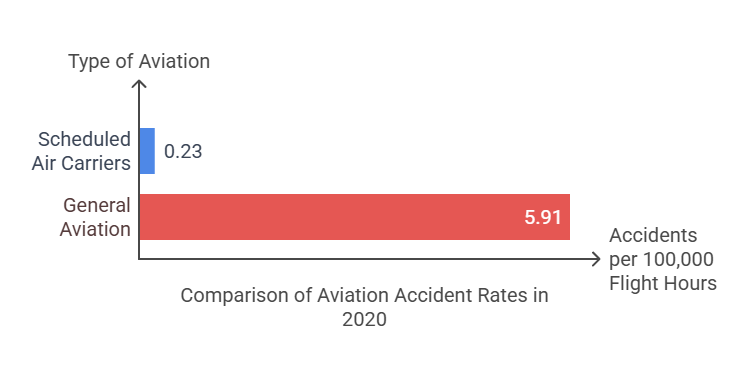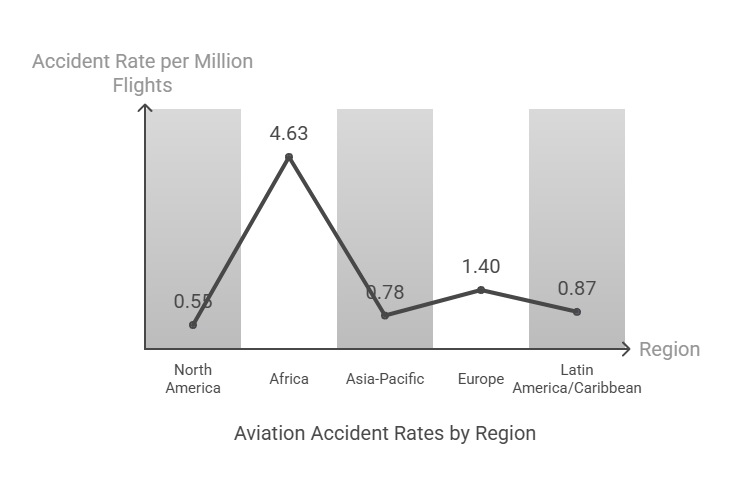Aviation is one of the safest ways to travel, with commercial aviation achieving zero fatal accidents in 2023 and a 38.5% drop in accident rates compared to 2022. However, private aviation remains significantly riskier, with 25 times more risk than commercial flights. Key safety improvements include advanced technology, stricter regulations, and better training programs, but challenges like cybersecurity threats and gaps in private aviation safety persist.
Key Highlights:
- 2023 Commercial Aviation Jets:
- 0 fatal accidents, 0.80 accidents per million sectors.
- Fatality risk rate: 0.03 per million sectors.
- Private Aviation Risks:
- 5.91 accidents per 100,000 flight hours in 2020, vs. 0.23 for commercial flights.
- Global Safety Variations:
- Accident rates (2024): North America 0.55, Africa 4.63, Europe 1.40 (per million flights).
- Emerging Risks:
- 55% of airlines faced cyberattacks in 2022.
- Helicopters have 30% higher accident rates than fixed-wing aircraft.
Aviation safety continues to improve, but private aviation, regional disparities, and digital vulnerabilities need urgent attention.
Map of Fatal Airplane Crashes in 2024
Past Aviation Accident Data
Flight Hour Safety Records
Data from the NTSB highlights a steady drop in aviation accidents over time. Between 2011 and 2020, U.S. civil aviation saw accident rates decline to 5.23 per 100,000 flight hours, with 0.94 fatal accidents per 100,000 flight hours [1].
Commercial vs Private Flight Safety
Despite advancements across the industry, the safety gap between private and commercial flights remains stark, with private aviation showing 25 times more risk than commercial operations. For instance, in 2020, scheduled air carriers (Part 121) recorded only 0.23 accidents per 100,000 flight hours. On the other hand, general aviation reported a much higher accident rate of 5.91 per 100,000 flight hours during the same year [1].
General aviation continues to account for the majority of accidents, as shown in the data from 2018 to 2020:
| Year | Total Accidents | Fatal Accidents | Fatalities |
|---|---|---|---|
| 2020 | 1,139 | 205 | 349 |
| 2019 | 1,220 | 233 | 414 |
| 2018 | 1,334 | 237 | 393 |
These numbers underline the ongoing challenges in improving safety for general aviation, which will be discussed further in upcoming sections.
Safety Differences by Region and Aircraft
Safety Records by Region
Aviation safety varies widely across the globe, with more developed regions typically achieving lower accident rates. According to IATA‘s 2024 Safety Report, accident rates per million flights show a clear contrast: North America (0.55), Africa (4.63), Asia-Pacific (0.78), Europe (1.40), and Latin America/Caribbean (0.87) [1]. These differences often reflect disparities in regulatory standards and enforcement.
Regions with stronger safety frameworks tend to excel due to factors like:
- Strict enforcement of safety regulations
- Modern airport facilities
- Comprehensive aircraft maintenance standards
- Consistent pilot training programs
Aircraft Type Risk Assessment
The type of aircraft and its mission profile also play a role in safety. For instance, in 2023, turboprop aircraft reported a hull loss rate of 0.57 per million flights and 0.31 fatalities per million flights, while jets had no hull losses and just 0.01 fatalities per million flights [1]. Turboprops often face greater risks because they are commonly used in areas with less developed infrastructure.
Helicopters in the U.S. also have a higher accident rate – about 30% more than fixed-wing aircraft – due to their frequent low-altitude operations [4].
Current Safety Risks
Private Aviation Safety Issues
Private aviation has seen rapid growth, but safety concerns remain a pressing issue. In 2019, there were 5.21 accidents per 100,000 flight hours in private aviation, compared to just 0.078 for commercial aviation [5]. Despite advancements in overall industry safety, these gaps persist.
Key challenges for private aviation include:
- Less frequent maintenance checks and reduced regulatory oversight.
- Operational risks tied to smaller aircraft designs.
- The use of under-equipped airports, which increases safety risks for smaller planes.
Digital Security Threats
Safety concerns extend beyond physical risks to include growing digital vulnerabilities. In 2022, 55% of airlines reported experiencing cyber attacks, and 61% of industry professionals noted an increase in potential threats [2]. Real-world incidents, like the EU Aviation Safety Agency‘s 2019 warning about GPS spoofing in the Eastern Mediterranean [6], highlight the seriousness of these risks.
Some of the most pressing digital threats include:
- Navigation system compromises, such as GPS spoofing or jamming.
- Vulnerabilities in flight operations, including breaches in air traffic control or communication systems.
- Weaknesses in electronic flight bags, which are increasingly used by pilots.
Pilot Training Requirements
Human factors play a critical role in aviation safety, particularly when it comes to pilot training. As technology advances, training programs need to address both traditional and emerging challenges.
Key areas of focus for pilot training include:
- Mastering advanced flight systems.
- Developing cybersecurity awareness to recognize and respond to digital threats.
- Retaining manual flight skills to avoid over-reliance on automation.
The FAA stresses the importance of balancing technological proficiency with fundamental piloting skills to ensure pilots remain prepared for all scenarios.
Why small planes are more likely to crash than commercial airlines
Summary and Recommendations
Aviation safety has made steady progress over the years, but ongoing risks highlight areas that need further attention. Here’s a closer look at key findings and steps for improvement.
Key Safety Findings
Over the past three decades, aviation safety has consistently improved. Data from 2023 shows encouraging trends, especially in commercial aviation:
| Aviation Sector | Safety Metrics (2023) |
|---|---|
| Commercial Aviation | 1.87 accidents per million departures |
| Total Accidents | 66 incidents |
| Fatality Rate | 17 people per billion passengers |
Steps to Enhance Safety
To address current challenges, three main areas require focus:
- Private Aviation Gaps
Strengthen this sector by introducing mandatory reporting systems, standardizing training requirements, and enforcing stricter maintenance protocols. - Adopting Advanced Safety Technologies
Invest in collision avoidance systems, upgrade cockpit technology, and improve ground safety mechanisms to reduce risks. - Modernizing Training Programs
Prioritize strategies to prevent loss of control in-flight (LOC-I) accidents, enhance ground operation safety measures, and promote international safety partnerships.
A recent incident in Tokyo involving an A350 and a Dash-8 turboprop (January 2024) serves as a reminder of the risks. As detailed in the sections on Digital Security Threats and Pilot Training [3], this collision highlights the need for ongoing safety advancements, even as accident rates decline.





